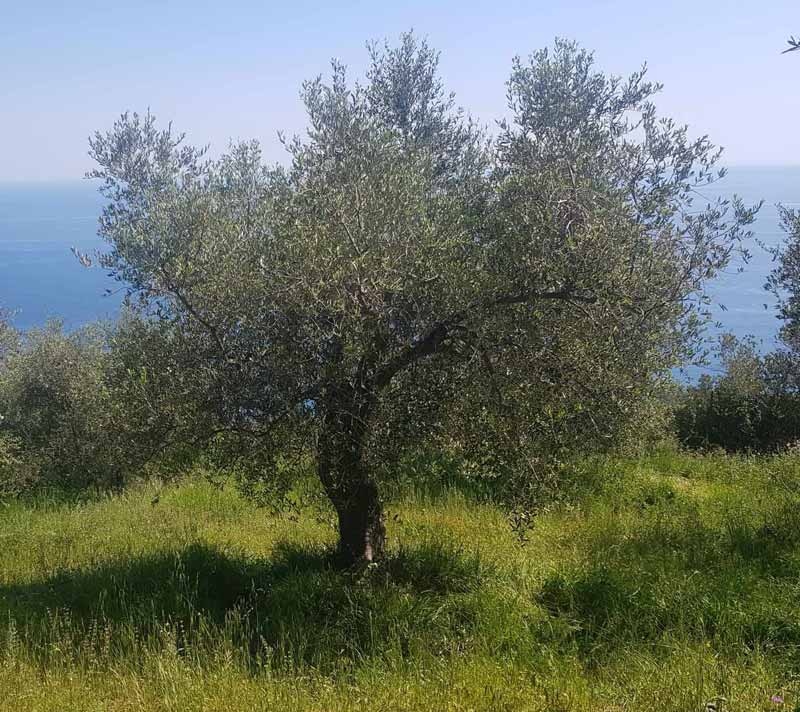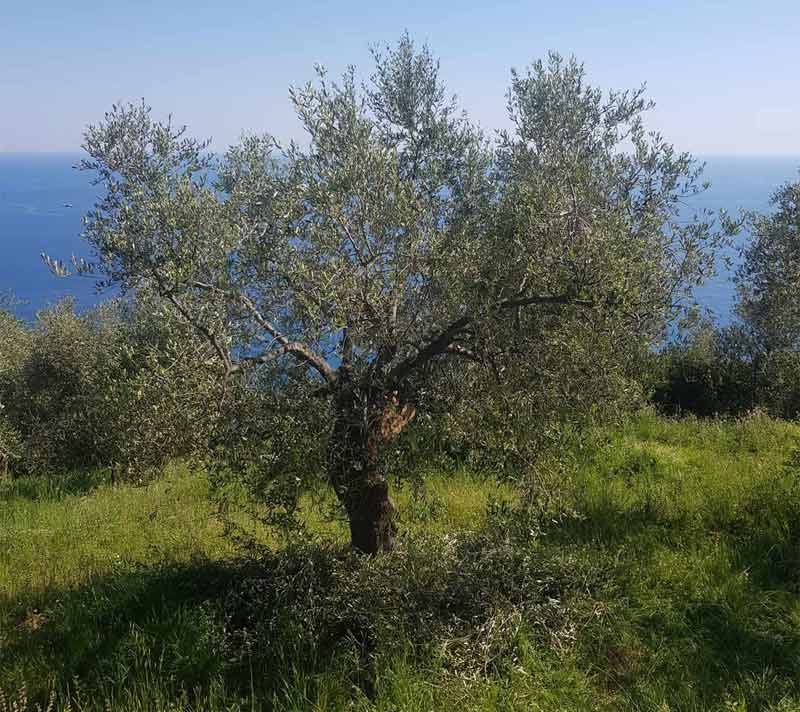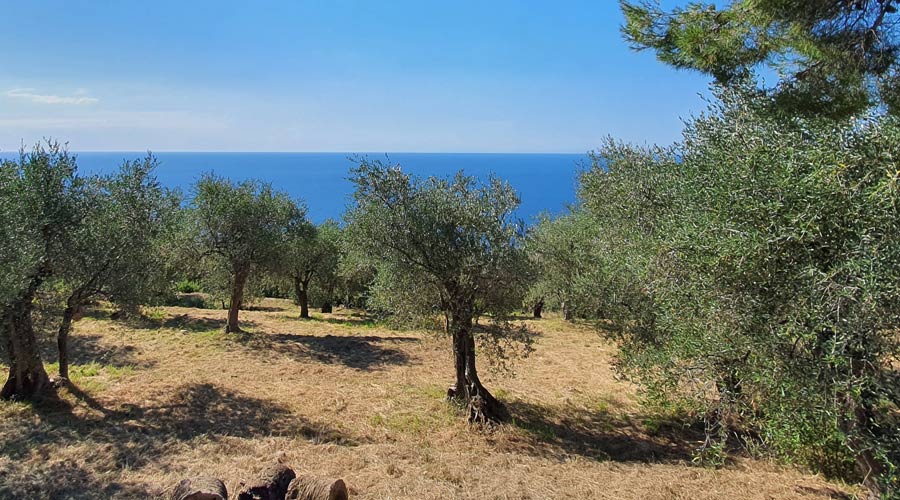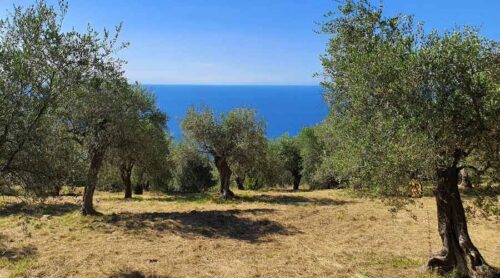Drag the white line to the right or left to see the before/after effect.


Olive Tree Pruning: the 10 Best Tips
Based on Sassolive Farm’s practice & scientifically sound – ideal if you want to adopt an olive tree and understand its care.
Olive Tree Pruning: Experience, Knowledge, and a Lot of Love for the Trees
The picturesque farm Sassolive grows over 1,200 organically grown olive trees. These trees need careful and competent care to reach their full potential and deliver the expected harvest. In particularly productive years, this cultivation can lead to up to 2,000 liters of premium organic olive oil being produced. Anyone who wants to adopt an olive tree will experience this rhythm firsthand.
The care cycle follows a fixed annual schedule:
- Pruning olive trees in January and February: Optimize structure and prepare the tree for the season.
- Fertilizing in March and April: Targeted nutrient supply for growth and fruit set.
- Protection in summer: Protect against heat and pests.
- Harvest from October 1st: The culmination of a year of hard work.
If you want to adopt an olive tree, you will experience this annual cycle from winter pruning to the freshly bottled oil.
A crucial factor is rain, especially in December/January, when olive trees form their flower clusters – water scarcity reduces flowering and thus the harvest. Anyone who wants to adopt an olive tree quickly understands how important this phase is.

While olive trees are relatively drought-tolerant, extreme drought (like in 2022) causes trees to drop fruit. Anyone who wants to adopt an olive tree will see that water and pruning management are always intertwined.
Pruning for production differs significantly from ornamental pruning: the goal is high, consistent quality and yield at a manageable tree height (3–4 m) – which facilitates harvesting. Especially if you want to adopt an olive tree, this working height is invaluable.
If trees grow significantly too tall (up to 6 m), a radical rejuvenation cut helps: leave the trunk with a few shoots; the tree will sprout again; select 3–4 future main branches from these. You can also experience this live if you want to adopt an olive tree and accompany its regrowth.
The 10 Best Tips for Olive Tree Pruning
1) Shaping Goal “Light & Air”: Open Canopy Instead of a “Broom”
An open, well-ventilated canopy dries faster, reduces disease pressure, and promotes uniform fruit set. The goblet-shaped (vase) canopy with 3–4 well-distributed main branches is proven; the interior remains permeable to light.
2) the Right Time
Late winter to very early spring, as soon as severe frosts are over and before vigorous budding. This allows cuts to heal quickly and the season to start with a structured canopy. Anyone who wants to adopt an olive tree can experience the winter pruning with us.
3) Know where the Fruits Grow
Olives primarily bear fruit on one-year-old shoots (grown in the previous year). Consequence: Annually remove old, poorly bearing wood and promote young wood – instead of just “shearing” the canopy short.
4) Use Pruning Types Correctly: “Thinning out” before “Shortening”
Thinning out (removing entire branches at the base) opens the canopy and maintains its architecture. Shortening (cutting tips) produces many water shoots; therefore, use sparingly and purposefully.
5) Remove Water Shoots & Competing Shoots Early
Steeply growing water shoots inside and suckers at the trunk take away light, vigor, and order. Remove them early – especially useful if you want to adopt an olive tree and desire a stable yield structure.
6) Train Young Trees, Maintain Old Trees
Training cut: Build a framework with 3–4 main branches, keep the interior open, remove competing shoots. Maintenance cut: Remove old/shading wood, promote renewal shoots. You will learn both practically if you want to adopt an olive tree.
7) Prune in Moderation (Rule of Thumb: Max. 25–30% per Year)
Excessive pruning stresses the tree, promotes water shoots, and temporarily reduces yield. Anyone who wants to adopt an olive tree will see firsthand how moderate pruning maintains balance.
8) Tool Hygiene & Clean Cutting Technique
Sharp, clean tools reduce bruising and infection risks. Make cuts flush with the branch collar (without stubs), avoid large wounds.
9) Rejuvenation of Old or Neglected Trees
Gradually bring “overgrown” trees (over 2–3 years) to a working height or perform a strong cutback with new growth (select 3–4 main branches). Afterward, consistently regulate water shoots – ideally experienced if you want to adopt an olive tree.
10) Keep an Eye on the Climate
After drought/heat, prune more gently (more leaves = more photosynthesis/protection); after strong growth, thin out a bit more vigorously. This keeps quality and stability high – important if you expect “your” oil year after year with your adopted olive tree.
Training Pruning: for the Perfect Canopy
Training pruning aims for a permanently sustainable canopy structure. In practice, this means:
- Clearly define the outer canopy shape
- Keep the inner structure permeable to light
- Establish hierarchy between main and secondary branches
- Remove weak or unsustainable wood
Marking photos of the canopy beforehand helps enormously with planning & teamwork. Anyone who wants to adopt an olive tree with us can follow this planning on their own tree.
Maintenance Pruning: Vital & Yield-Ensuring
During maintenance pruning, we remove dead wood, damaged parts, and overgrown, shading branches. If necessary, we cut back to healthy wood – followed by good care for vigorous new growth. A simple vitality test (green vascular tissue under the bark) shows whether a branch is alive. You will also experience this if you want to adopt an olive tree.
Pruning Olive Trees – a Matter of Light
Olives bear fruit on young wood – therefore, annually remove old, poorly bearing wood, promote young wood, and shorten or remove shading branches over lower fruit zones. Precisely this logic distinguishes “nicely pruned” from yield-secure.
For us as organic farmers, pruning is part of our philosophy: without chemicals, with natural means and a lot of manual labor. This is more elaborate – but sustainable. If you want to connect emotionally, you can adopt an olive tree with us; this way, you follow the development of “your” tree from pruning to bottle.
Adopt an Olive Tree: Learning in Practice
To adopt an olive tree is more than a gift – it’s an invitation to truly understand its care. During farm visits, you see live how pruning, fertilizing, protection, and harvesting intertwine. Thus, adopting an olive tree becomes an annual project where you experience everything from winter pruning to the oil. Your olive tree adoption also supports our sustainable cultivation – a win-win for the tree, nature, and you.
FAQ – Olive Tree Pruning (Quick Answers)
- When is the best time to prune olive trees?
- In practice: Late winter to very early spring, as soon as severe frosts are over and before vigorous budding. Anyone who wants to adopt an olive tree with us can be there exactly then.
- Why should the canopy remain open?
- More light & air inside reduce disease pressure, improve flower and fruit quality, and facilitate harvesting. The “vase” principle with 3–4 main branches is ideal for this.
- Where do olive tree fruits grow?
- Mainly on one-year-old shoots that grew in the previous year – therefore, annually reduce old wood and promote young wood.
- How much can I prune?
- As a rule of thumb, no more than approx. 25–30% of the canopy per year. Excessive pruning leads to water shoots and yield interruptions.
- What to do with water shoots and suckers?
- Remove them early – they shade, consume vigor, and disrupt the canopy’s order.
- How do I best train young trees?
- Build a framework of 3–4 main branches, keep the interior open, remove competing shoots. Later switch to maintenance pruning.
- Is radical cutback possible for old trees?
- Yes – as a rejuvenation cut with subsequent regrowth. Afterward, regulate water shoots and select new main branches. Ideally experienced if you want to adopt an olive tree.
- Do I need wound sealants?
- More important than “sealing” are clean, sharp cuts at the branch collar and good timing. Avoid large wounds if possible.
- Can I prune directly after harvest?
- In many regions, work is done between harvest and budding – the main thing is that severe frosts are over and the tree starts structured.
- I want to learn more – what exactly does adopting an olive tree offer me?
- You accompany “your” tree throughout the year: winter pruning, fertilizing, protection, harvesting – and receive the oil. Adopting an olive tree combines knowledge, enjoyment, and nature conservation.
Interested? Here you can adopt an olive tree – and join us live for the next pruning.



